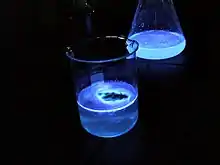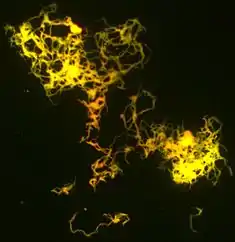Luminescence
Luminescence is the "spontaneous emission of radiation from an electronically excited species (or from a vibrationally excited species) not in thermal equilibrium with its environment", according to the IUPAC definition. A luminescent object is emitting "cold light", in contrast to "incandescence", where an object only emits light after heating.[1] Generally, the emission of light is due to the movement of electrons between different energy levels within an atom after excitation by external factors. However, the exact mechanism of light emission in "vibrationally excited species" is unknown, as seen in sonoluminescence.


The dials, hands, scales, and signs of aviation and navigational instruments and markings are often coated with luminescent materials in a process known as "luminising".[2]
Types
- Radioluminescence, a result of bombardment by ionizing radiation
- Electroluminescence, a result of an electric current passed through a substance
- Cathodoluminescence, a result of a luminescent material being struck by electrons
- Chemiluminescence, the emission of light as a result of a chemical reaction
- Bioluminescence, a result of biochemical reactions in a living organism
- Electrochemiluminescence, a result of an electrochemical reaction
- Lyoluminescence, a result of dissolving a solid (usually heavily irradiated) in a liquid solvent
- Candoluminescence, is light emitted by certain materials at elevated temperatures, which differs from the blackbody emission expected at the temperature in question.
- Mechanoluminescence, a result of a mechanical action on a solid
- Triboluminescence, generated when bonds in a material are broken when that material is scratched, crushed, or rubbed
- Fractoluminescence, generated when bonds in certain crystals are broken by fractures
- Piezoluminescence, produced by the action of pressure on certain solids[3]
- Sonoluminescence, a result of imploding bubbles in a liquid when excited by sound
- Crystalloluminescence, produced during crystallization
- Thermoluminescence, the re-emission of absorbed energy when a substance is heated[4]
- Photoluminescence, a result of the absorption of photons
- Fluorescence, traditionally defined as the emission of light that ends immediately after the source of excitation is removed. As the definition does not fully describe the phenomenon, quantum mechanics is employed where it is defined as there is no change in spin multiplicity from the state of excitation to emission of light.[1]
- Phosphorescence, traditionally defined as persistent emission of light after the end of excitation. As the definition does not fully describe the phenomenon, quantum mechanics is employed where it is defined as there is a change in spin multiplicity from the state of excitation to the emission of light.[1]
Applications
- Light-emitting diodes (LEDs) emit light via electro-luminescence.[6]
- Phosphors, materials that emit light when irradiated by higher-energy electromagnetic radiation or particle radiation
- Laser, and lamp industry
- Phosphor thermometry, measuring temperature using phosphorescence
- Thermoluminescence dating
- Thermoluminescent dosimeter
- Non-disruptive observation of processes within a cell.[7]
Luminescence occurs in some minerals when they are exposed to low-powered sources of ultraviolet or infrared electromagnetic radiation (for example, portable UV lamps) at atmospheric pressure and atmospheric temperatures. This property of these minerals can be used during the process of mineral identification at rock outcrops in the field or in the laboratory.
History
The term "luminescence" was first introduced in 1888.[8]
See also
- List of light sources
- Scientific American, "Luminous Paint" (historical aspects), 10-Dec-1881, pp.368
- High-visibility clothing
References
- Valeur, Bernard; Berberan-Santos, Mário N. (2011-06-01). "A Brief History of Fluorescence and Phosphorescence before the Emergence of Quantum Theory". Journal of Chemical Education. 88 (6): 731–738. Bibcode:2011JChEd..88..731V. doi:10.1021/ed100182h. ISSN 0021-9584.
- Cooper, John R.; Randle, Keith; Sokhi, Ranjeet S. (2003). Radioactive Releases in the Environment: Impact and Assessment. Wiley. p. 192. ISBN 978-0-471-89924-2.
- Piezoluminescence phenomenon N. A. Atari Physics Letters A Volume 90, Issues 1-2, 21 June 1982, Pages 93-96 doi:10.1016/0375-9601(82)90060-3
- Meetei, Sanoujam Dhiren. "Synthesis, Characterization and Photoluminescence of ZrO2:Eu3+ Nanocrystals" (PDF). Retrieved 18 December 2014.
- Sidran, Miriam (1968). "The Luminescence of the Moon". In Kopal, Zdeněk (ed.). Advances in Astronomy and Astrophysics (Volume 6). Academic Press. p. 301.
- Jorio, Ado; Dresselhaus, Gene; Dresselhaus, Mildred S. (2007-12-18). Carbon Nanotubes: Advanced Topics in the Synthesis, Structure, Properties and Applications. Springer Science & Business Media. ISBN 978-3-540-72865-8.
- "Light-emitting particles illuminate understanding of cellular malfunctions - News & Media @ UOW". Archived from the original on 2018-06-12. Retrieved 2018-06-11.
- "Über Fluorescenz und Phosphorescenz, I. Abhandlung" (On fluorescence and phosphorescence, first paper), Annalen der Physik und Chemie, 34: 446-463. From page 447: "Ich möchte für diese zweite Art der Lichterregung, für die uns eine einheitliche Benennung fehlt, den Namen Luminescenz vorschlagen, und Körper, die in dieser Weise leuchten, luminescirende nennen." [For this second type of light excitation, for which we lack a consistent name, I would like to suggest the name of "luminescence", and call "luminescing" [any] bodies that glow in this way.]

.jpg.webp)
